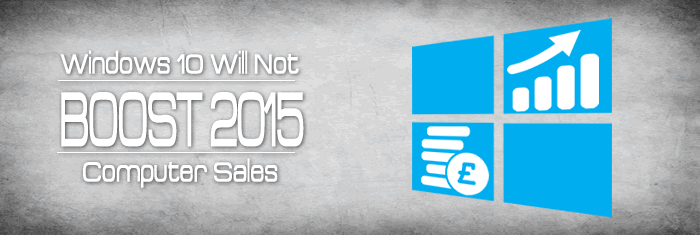Typically, new operating systems are intended to boost PC sales since they often demand new hardware for optimal performance, Technology researchers don’t think, Windows 10 Will Not Boost 2015 Computer Sales.
For decades, this has been a huge driver for PC makers. At first, consumers tend to move somewhat quickly to upgrade and in many cases they buy new PCs as part of the upgrade process. IT buying is slower, but after 2-3 years, many IT shops jump on the new OS bandwagon.
However, it appears that this tried-and-true formula will not replicate itself with Windows 10. One reason is Microsoft’s botched Windows 8 release, in which Redmond pushed a drastic new user interface. Business buyers avoided it like the plague, and consumers only upgraded when they were forced to buy a new PC.
With Windows 10, Microsoft has seen the folly of its ways and finally included the Start button and made toggling back to Windows 7 easier. This new OS should help expand PC sales, though some PC makers are nervous. Most tech researchers estimate that 2015 PC sales will be 3-4 percent below last year’s sales, which were already 7-10 percent lower than the year before. No OEMs I have talked to expect much of a bump in PC sales because of Windows 10.
Part of the reason is that people are not upgrading PCs as often as they did in the past. In the early years of the PC, consumers upgraded every 2-3 years and businesses upgraded every 3-4 years. Both groups are holding on to machines much longer these days.
The second and perhaps the most important reason is that in the past, the PC was the only way people could connect to the Internet, email, apps, and more. Today there are a variety of mobile gadgets that do the same, from smartphones and tablets to Chromebooks and even smart TVs.
For many, especially consumers, the PC has been pushed to the back burner and used mostly for personal productivity or educational purposes. There is no sense of urgency to upgrade a PC because of a new OS and consumers will only do this as a natural upgrade process driven by an aging PC.
Interestingly, after years of trying to find ways to boost PC sales, most of the PC vendors have concluded that they will only sell between 280-320 million PCs a year and the days of PC growth has ended. Now they are focusing on innovating around PCs and laptops and fighting the competitive battle with other PC vendors. The good news for the big PC vendors is that they have diversified. While PCs are still key to their business, they now offer servers and rich services, allowing them to stay profitable. But this shift towards a slowing PC market will really hurt those who are not in the top tier. Second- and third-tier PC vendors will find it hard to compete with the likes of Lenovo, HP, Dell, and Apple.
On the other hand, Windows 10 should be a big hit for Microsoft. The PC vendors still have to pay a license fee to Redmond for every PC that is shipped with their OS even if their own margins are being squeezed. Also, with Windows 10 being a free upgrade, Microsoft’s goal now is to have a billion devices with Windows 10 on them within the next three years, which it hopes will finally drive software developers to make apps for its OS.
Windows 10 is a solid new OS that will eventually drive the next generation of PC sales. However, the days of it giving PC vendors an immediate boost are long gone. PC vendors are going to have to live with a market where the demand for PCs is forever stable and never growing again.


